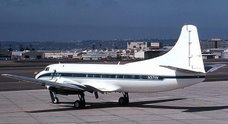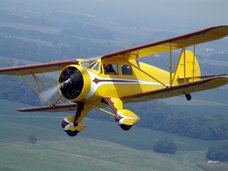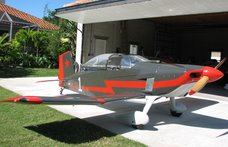Chapter 3: Airways & Airwaves ©
THAT PUP WAS MY COPILOT!
by David Gwinn On most airline jet aircraft, the forward cargo compartment is heated. That, therefore, is where we can carry live animals. If the heater fails, the Minimum Equipment List stipulates that no live animals may be loaded.
We were th

e last flight that night from St. Louis to Houston. I’d noted that we have no forward cargo bin heater and the rules precluded carrying live animals that night in that compartment.
The ramp agent arrived in the cockpit to tell me about a dog in a kennel. “Well, I’m sorry”, I commented, “but, as you know, we can’t load him.” The baggage handler felt compassion for the pup, and asked if I’d come down and look at the kennel and situation.
On that dark ramp, I was seeing about one-third of that kennel. It looked small to me. I said: “Oh, heck. Bring it up to the boarding door and let’s see what we can negotiate with the flight attendants.”
It contained a full-grown Spaniel, about 65 pounds. The flight attendants immediately stated: “No way! You can’t put him in the galley. We have no room anywhere for that kennel. No way!” I asked the agent to see if the kennel would even fit in the cockpit, on the floor, behind the pilots. It wouldn’t even fit through the door.
While we examined the possibilities, a bespeckled, gentle looking man, with evident sadness in his eyes came up front and asked: “Am I going to have to stay in St. Louis? That’s my dog.”
I said: “Well, I hope not. We’re trying to figure something out.”
He added: “We were booked on Northwest and they cancelled the flight. They rebooked us on TWA. I’m just coming from my father’s funeral. That was his dog. I’m trying to take Babe home to Texas.”
I asked: “How old is that dog?”
“About nine years old.”
“Is he gentle?”
“Very. The sweetest pup on the planet.”
“OK. I want all of you flight attendants to form a wall so the passengers don’t observe this. Take him out of the kennel, put him in the cockpit and latch him to that cargo strap. No one is to come up here or open that door en route. I want every passenger off the airplane before I bring Babe out of here.”
Ol’ Babe lay down and slept the whole way. Occasionally I reached back to scratch his ears and he licked my hand. He was truly “the sweetest pup on the planet.”
In Houston, I took off my belt, looped it around Babe’s collar and led him up the jetway. The Station Manager was astounded: “You can’t do that! That is illegal?”
“What’s illegal?” I asked.
“Carrying a dog in the cockpit!”
“No, now wait a minute”, I replied. “I looked in the Flight Operations Policy manual and it says you cannot, under any circumstances, carry a dog in the cabin in other than a kennel. It says nothing about the cockpit. Besides, that dog was twice as smart as my copilot and I needed his help.”
Babe’s new Pappy was delighted. I was too. It’s nice to be nice to nice people.
In the crew van, the copilot said: “That was really nice of you. You better hope he doesn’t write a letter of commendation.”
Oh-ma’Gawd! I never thought of that. And he did write one.
I was informed of his letter by an inter-company complimentary letter from the Chief Pilot. The owner’s letter appeared in the Reservation Agent’s monthly publication: “Capt Gwinn gave my dog genuine first class service. We are forever
grateful.” It was reprinted twice elsewhere.
I had a Junior Captain certificate made up for Babe and also sent a set of the plastic Captain’s wings.
One day I asked the Chief Pilot if he wanted to hear ‘the whole story’ on the transportation of the dog. “I’m sure I don’t want to know,” he replied.
***
© David Gwinn, all rights reserved. Used here with the author's permission. To order Airways & Airwaves © or any of Gwinn's books, go to: http://www.davegwinn.com/ Retired TWA Captain David Gwinn with 15,000 hours, 15 pilot certificates and 5 instructor certificates, is internationally recognized as a consummate aviation educator.




